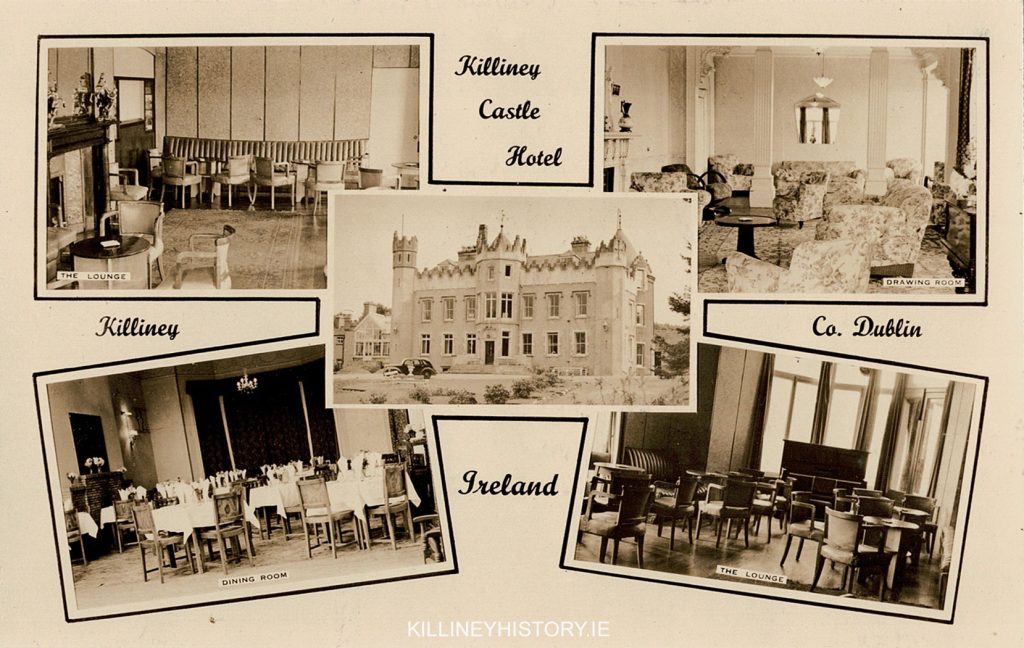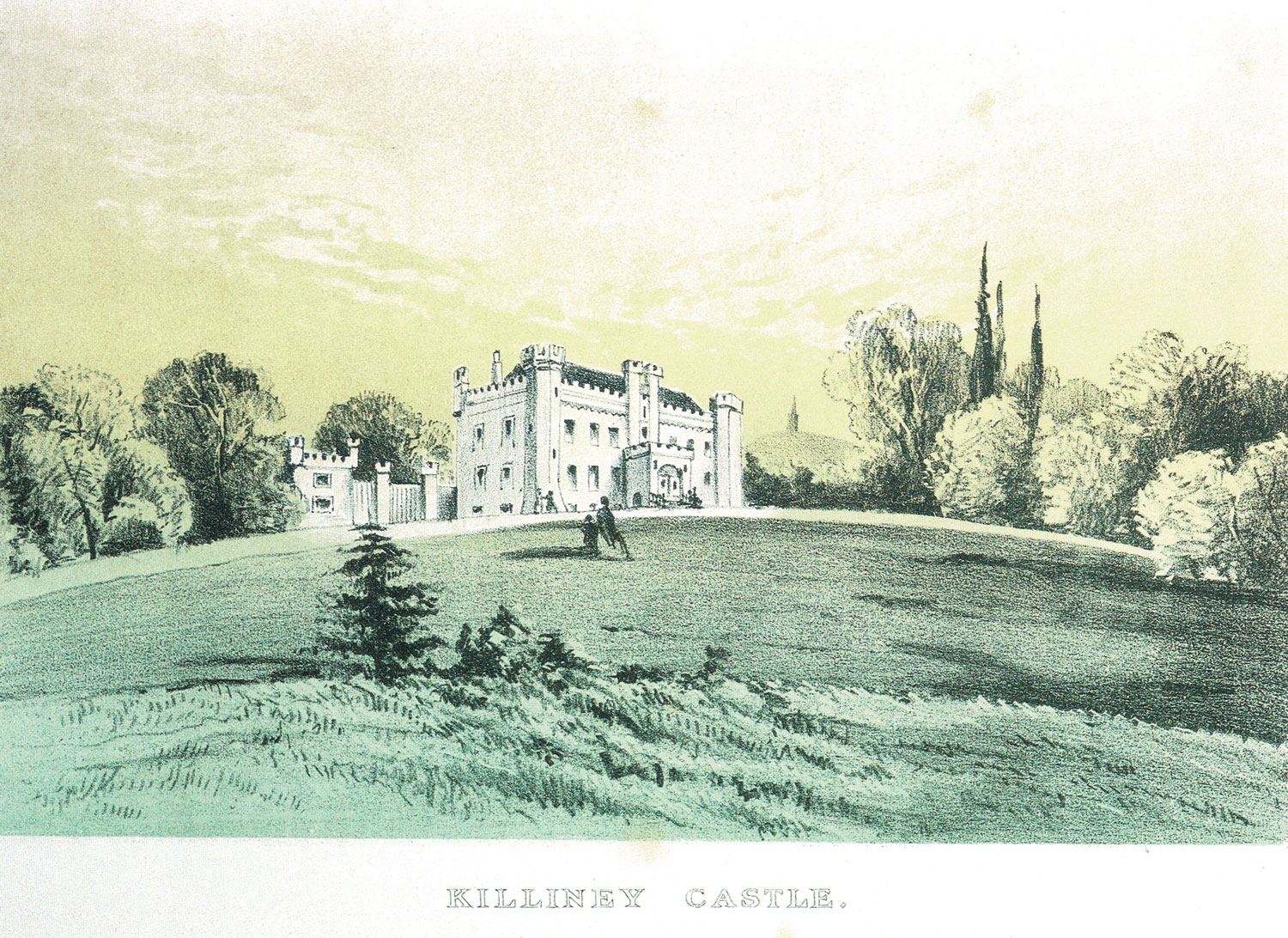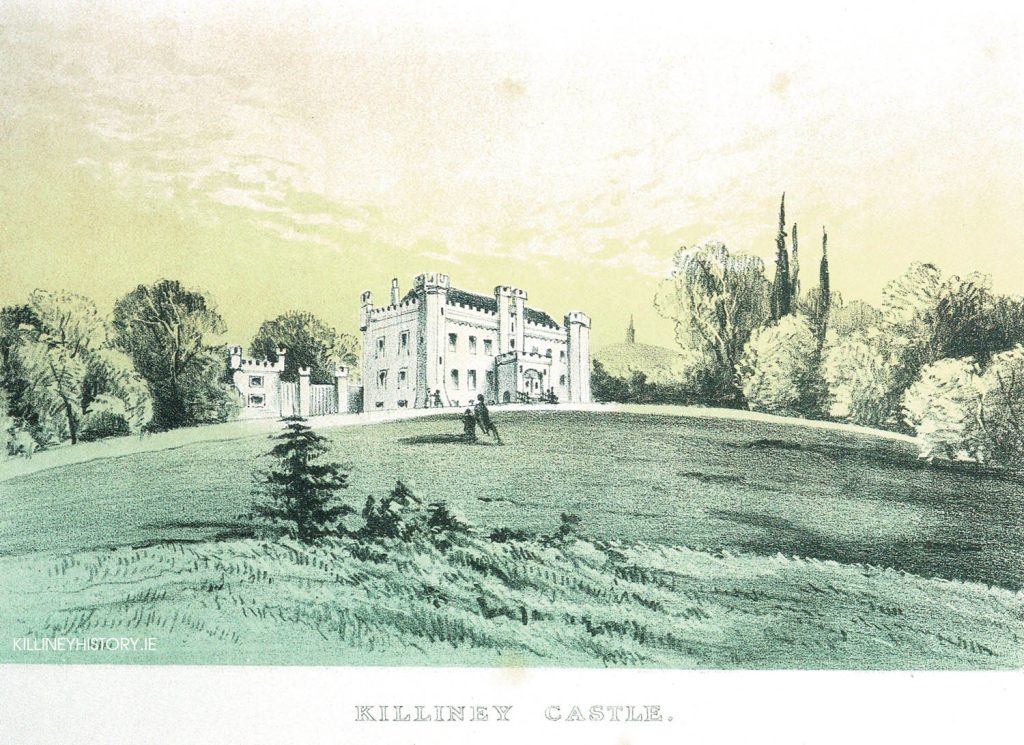
Killiney Castle Estate Ownership/Occupiers Chronology
1218 Talbots of Malahide are granted Rochestown Estate (inc. Killiney Hill) by the Crown for an annual rent of 1 Goshawk. Loyal Norman subjects were granted lands on the borders of the Pale.
1740 John Malpas/Mapas from Co. Louth claimed the land and built 3 fine houses on it including Mount Malpas/Mapas on Killiney Hill.
1755 Captain Edward Maunsell, the then High Sheriff of Co. Dublin renamed it Roxborough
1764 Henry Loftus, MP for Bannow Co. Wexford, later to become Viscount of Ely renamed it Loftus Hill. Loftus cut a carriage way around the east side of the hill, still in existence, though now tarred and referred to as ‘the green road’. He also planted the west side with tree and shrubs.
1778 It was the residence of Mr Medlicott, before it passed to a Mr Minchin.
1787 Humphry Minchin is indicated as leaseholder on Sherrard Map
1790 John Scott, Lord Clonmel also known as ‘Copperfaced Jack’ claimed the property. He employed 200 men to work on the estate and stocked it with deer at a cost of £3,000.
1797-1832 Thomas Bourchier, Clerk of the Crown and Hanaper and Usher of the Black Rod in the Irish House of Commons. Built the small obelisk memorial to the Mapas family on Killiney Hill. In 1835 the house was named Mount Malpas and was the home of Mr. Boucher [sic], according the The Dublin Penny Journal, although Mr. Bourchier had died in 1832.
1832 23rd June, death of Thomas Bourchier
1834 26th February, Killiney Castle and Mount Malpas are put up for auction. 1st March, Newspaper report of sale of Mount Malpas Estate for £7,000
1837 On the Ordnance Survey Map the house is named as Killiney Castle.
1834 Robert Warren (senior), a lawyer and property speculator owned the estate but it appears that he only came to live here in 1846 after moving from Baymount Castle in Clontarf. Warren enlarged the house and added mock medieval corner towers, turrets and battlements. He also restored and added to the monuments on the hill and built Victoria Castle and several other houses in the area including Wyvern House where one of his sons lived. Robert Warren had plans drawn up to develop the entire estate into c.160 plots of terraces and single dwellings. The plan was abandoned when following his death his estate got into difficulty and his assets were sold off.
1869 Robert Warren (senior) dies on 29th June 1869
1873 Robert Warren (junior)
1874-1876 Richard Martin, Esq., DL
1877-1880 Jesuit House
1880-1906 T. Chippendall Higgin
1907-1937 Alfred.H. Ormsby-Hamilton, MA, DL, Barrister-at Law
1938-1948 Michael J. Heeney
1912-1940 Historical records of property ownership in the War years are scant. During this period we do know that Killiney Castle lay vacant for some time and went into disrepair. At some point it was in the hands of the British Army, who used it as their HQ and subsequently, in the Free State in the hands of the IRA.
1940’s – 1971 Killiney Castle was acquired by the Murphy/Keenans who refurbished it and ran a successful B&B.
1971 – today Killiney Castle exchanged hands again with the late Paddy and Eithne Fitzpatrick taking over the helm in the 1971, transforming it into a first class hotel and re-naming it Fitzpatrick Castle Hotel. Today their daughter Eithne Fitzpatrick Scott-Lennon owns and runs the hotel together with her family.
Sources: various inc. ‘History of the Castle’ from Killiney Castle Hotel – © Emer Brady 2014 (updated by admin February 2022. See entries from Thom’s Directory at the end of this article)
Description by Peter Pearson (1998)
Peter Pearson ‘Between the Mountains and the Sea‘ (1998), pp 58-59.
In 1740 Colonel John Malpas built a house called Mount Malpas, now Killiney Castle, as a speculative development. Malpas must have let the castle in its early years, for in 1752 Falkiner’s Dublin Journal carried the following advertisement: ‘Roxborough, formerly called Mount Malpas, containing 150 acres of land enclosed by a stone wall and a new well-furnished house of six rooms and two large closets on a floor with offices.’

Certainly, Thomas Sherrard’s map of the Malpas estate, made in 1787, shows the castle to be a fairly modest house, with no elaborate gardens or plantations which would compare with Rochestown House, the principal Malpas residence.
Peter Wilson, writing about Dalkey in 1768, says that the new owner of Mount Malpas, the Right Hon. Henry, Lord Viscount Loftus of Ely, had made many improvements to the house and gardens. He comments on the magnificent view of the city, bay and harbour of Dublin, and describes the gardens as being ‘enclosed with high stone walls, stocked with the best fruit trees, and such a collection of flowers as must captivate the most insensible eye’.
Loftus was obviously possessed of a passion for improvement and, like Malpas before him, he carried out other major works in the area, including the cutting of a new carriage road around Killiney Hill, blasting stones and bringing earth to cover the bare out-crops of rock, and planting the west side of the hill with various types of trees and shrubs. Wilson also says that Loftus intended to build a banqueting house in the woods, but never realised his plan because in the meantime he had inherited Rathfarnham Castle, where he directed all his energies.
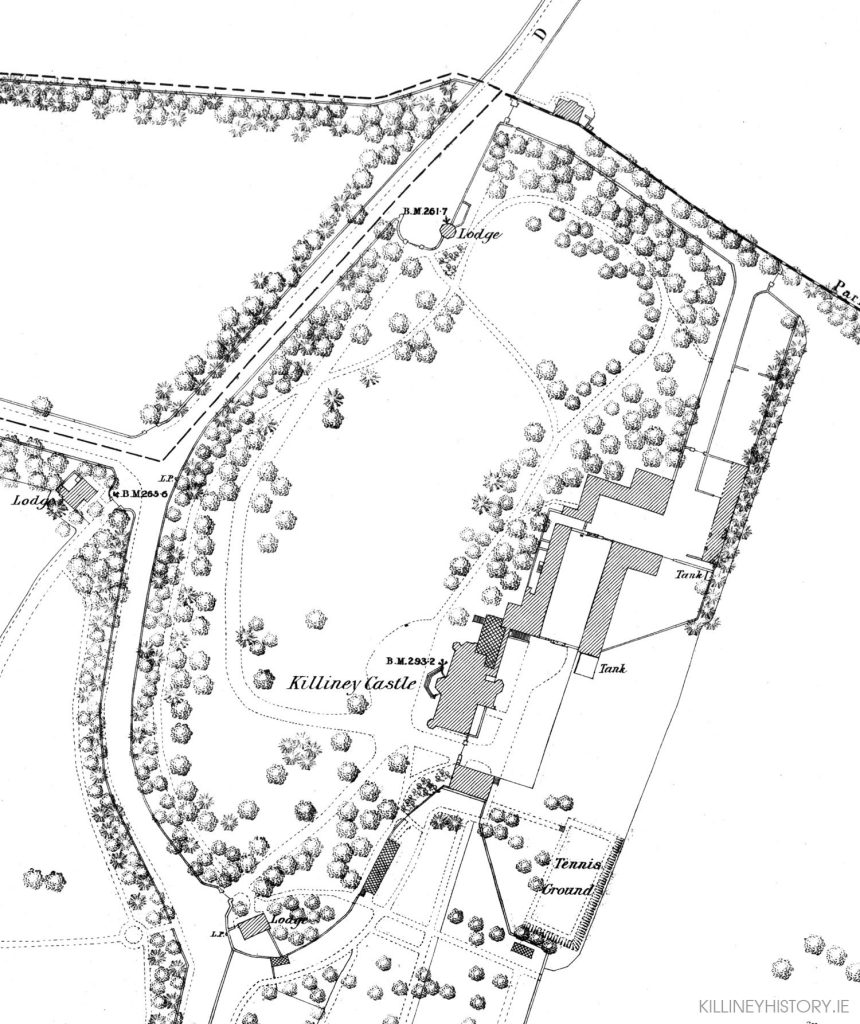
In 1790 another important landowner, John Scott, Lord Clonmel, leased Killiney Hill with the intention of building a large house there. Clonmel already had a very elegant house at Neptune in Blackrock, but presumably because he was so wealthy and was hungry for new projects, he spent large sums of money on the creation of a deer park at Killiney and employed many men in making roads and building walls.
The castle, which is now the centrepiece of Fitzpatrick’s Castle Hotel, does retain various features of the eighteenth-century structure, despite having been much altered since.
The original Mount Malpas was a seven-windowed, two-storey-over-basement, Georgian house. Sherrard’s map shows the castle in this form. It must have been Robert Warren, the nineteenth-century owner of the Killiney estate, who, in 1840, was responsible for the addition of the mock medieval corner towers, turrets and battlements.
As described by Peter Wilson in 1768. Extract from Gaskin’s Irish Varieties 1878. pp.56-57 (added 26.01.23)
A Topographical Description of Dalkey and the Environs, in a letter to John Lodge, Esq; deputy keeper of the Rolls.
Dalkey Lodge, March 28, 1768.
A little to the southward of Dalkey is a spacious house, belonging to the Right Honorable Henry, Lord Viscount Loftus, of Ely. This house is situated on the west side of Killiney, or, as it is now called, Loftus Hill, and, for prospect, cannot be surpassed, having in front the city, bay, and harbour of Dublin, with an immense number of villas and improvements along the coast, and an inland prospect equally rich. Although the house is large and roomy, yet, it must be confessed, the offices are mean and small, of which his lordship is so sensible, that he intends to build a new range, agreeable to a plan provided for that purpose. As for the gardens, they are inclosed with high stone walls, stocked with the best fruit-trees, and such a collection of flowers as must captivate the most insensible eye. Possessed of an unbounded passion for improvement, and a skill equal to that passion, this nobleman hath converted the most barren hills and rocks into good meadow and pasture fields, and laid them down remarkably neat and level, in the execution of which he hath been frequently obliged, first, to blast the rocks that spread themselves over the surface of the ground, and then draw mould to cover them. Besides this laborious, and, indeed, expensive undertaking, he has cut a carriage-road round the hill, and planted the west side with various kinds of trees and shrubbery. This road is walled in ; and, viewed in passing it, resembles the Welsh mountains, especially on the sea side, where the pending rocks hang frightful overhead, and appear ready to tumble down on the trembling passenger. The obelisk, erected on the top of this hill, may be seen at many miles’ distance , but hath little either in the design or execution to re commend it, being in both respects vastly inferior to that of Stillorgan ; but, as a good landmark, and an ornament to the house and neighbourhood, I wish to see it repaired, and not suffered to fall to decay. By an inscription thereon , it appears to have been built in 1741, the year after the great frost, by John Mapas, Esq ., with the benevolent intention of providing employment for the industrious poor. It is with peculiar satisfaction I learn that his lordship intends still improvements further, and, among others, to build an elegant banqueting-room somewhere about the back of the hill.
Thomas John Medlicott 1780
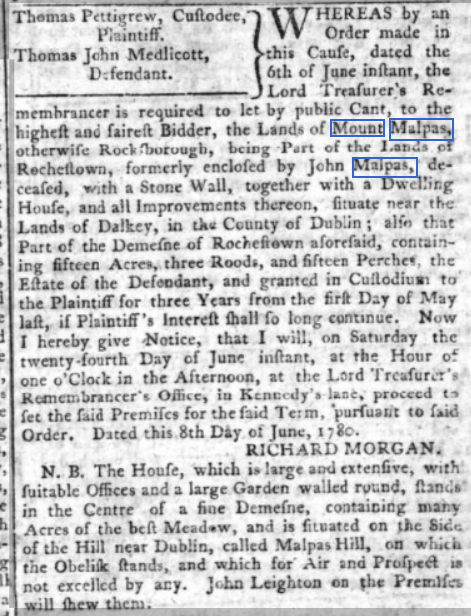
The Bourchier connection c.1797-1834
Thomas Bouchier/Bourchier, a soldier from Northamptonshire, settled in county Tipperary, at the beginning of the 18th century and his descendants intermarried with a number of families from county Clare, such as the McNamaras and McMahons. During part of the 18th century the Bourchiers resided at Elm Hill, near Broadford, county Clare. By the early 19th century their main residence was Killiney Castle, county Dublin. John Bourchier, grandson of Thomas mentioned above, was killed in a duel at eighty years of age. John’s youngest son, Thomas Bourchier, of Killiney Castle, County Dublin, was Clerk of the Crown and Hanaper and Usher of the Black Rod in the Irish House of Commons. He was appointed as Deputy Clerk on 7th July 1797 and this may coincide with his move to Loftus Hill. He married Dorothea, daughter of Rev. Hadlock, and their eldest son John Bourchier of Smithville, Nenagh, County Tipperary, and Killiney Castle, County Dublin, Barrister-at-Law, married Mary, daughter of Richard Townshend Herbert, of Cahirnane, County Kerry.
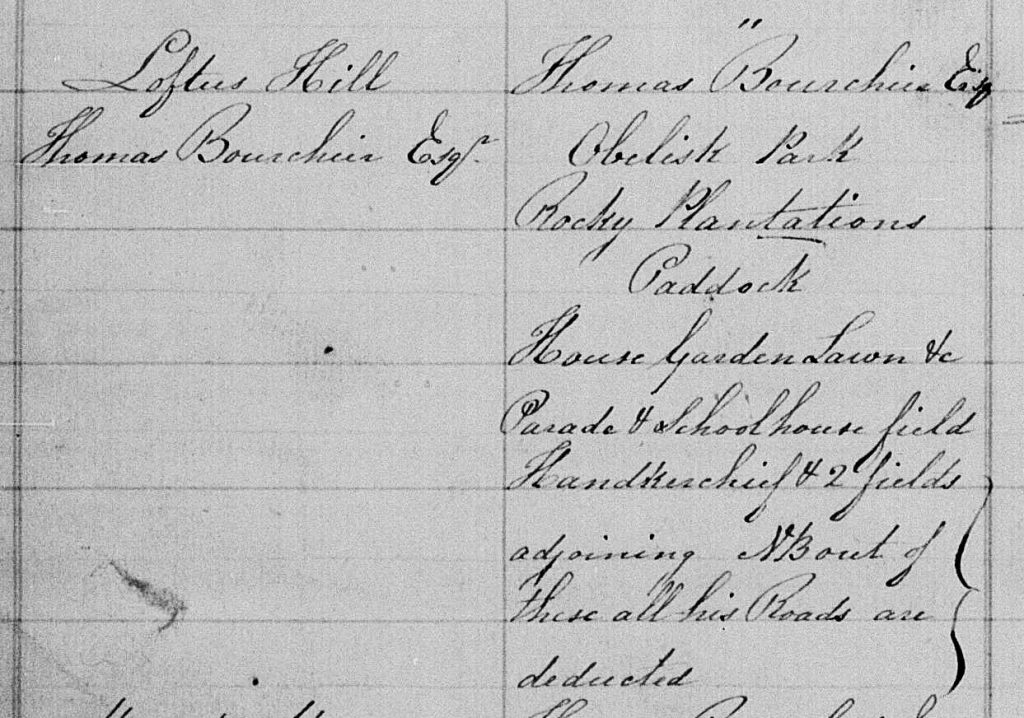
The Tithe Applotment Book (Church tax applied to occupiers of lands) entry of 1826 for Loftus Hill and Mount Mapas in the townland of Rocheshill, parish of Kill, lists the owner and occupier as Thomas Bourcheir Esq. His holding is described as ‘Obelisk Park, Rocky Plantations, Paddock, House Garden Lawn and Parade. Schoolhouse field, Handkerchief and 2 fields adjoining. NB out of these all his Roads are deducted’ The Mount Mapas holding also refers to a Banquet Field, Garden and Lawn.

Bourchier’s Obelisk
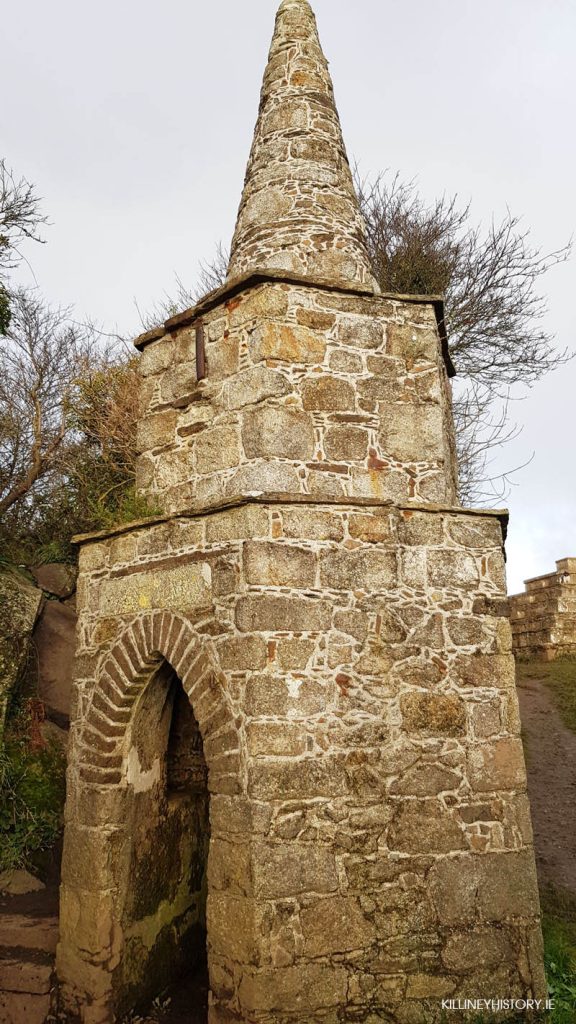
The Dun Laoghaire Rathdown County Council record of protected structures mentions Mount Mapas Obelisk and Monument (Boucher’s Monument), Killiney Hill Park. We believe that this refers to the smaller obelisk which is mentioned in Ball’s history which comments: ‘A tourist in 1796 mentions that a memorial was about to be placed on the hill, in pursuance of the will of the last Mr. Mapas, who left a large sum for the erection of a monument to his family.’ It appears that this work was carried out by Thomas Bourchier.

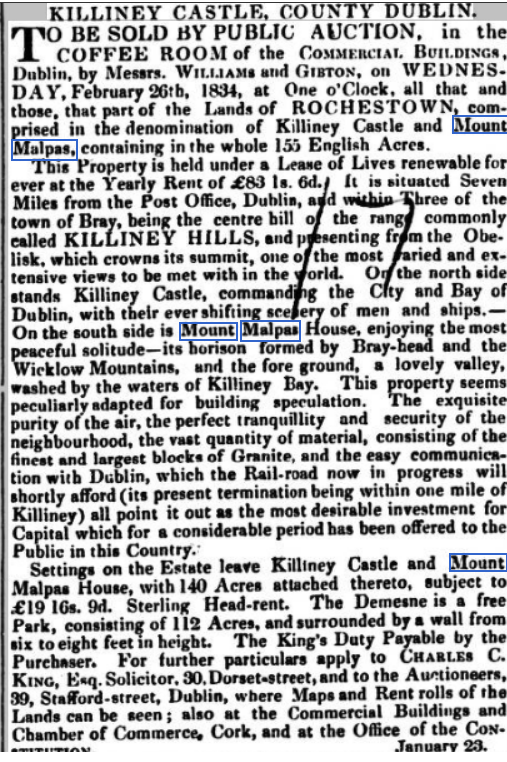

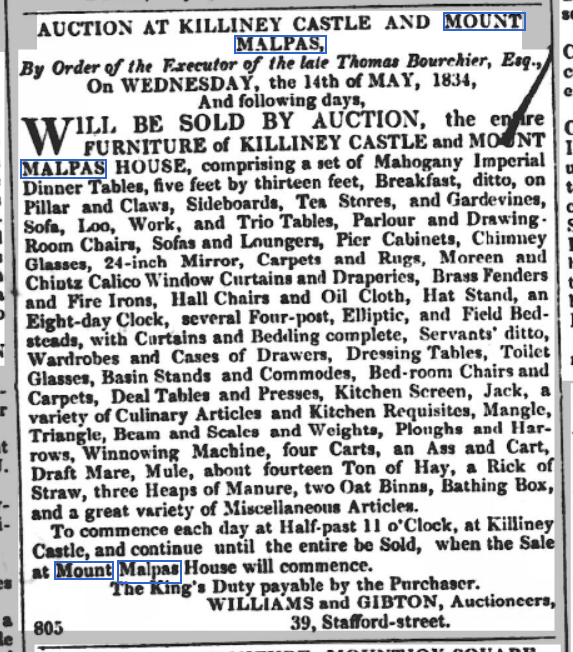
The Warren era c.1834-1872
Extract from Illustrated Incumbered Estates 1850-1905 by Mary Cecelia Lyons 1993 pp 239-240
Robert Warren (senior), on whose behalf this estate was being sold, was a solicitor who had a second career as a speculative builder. His main land base was in Killiney, and he had made a killing selling land to the Dublin and Bray Railway. Much of this fortune was spent on non-productive projects. Killiney House, Warren’s residence, acquired crenellations and became Killiney Castle. A church dedicated to Holy Trinity was erected on the demesne, and given to the Church of Ireland. There was also a great deal of improvement and ornamental planting.
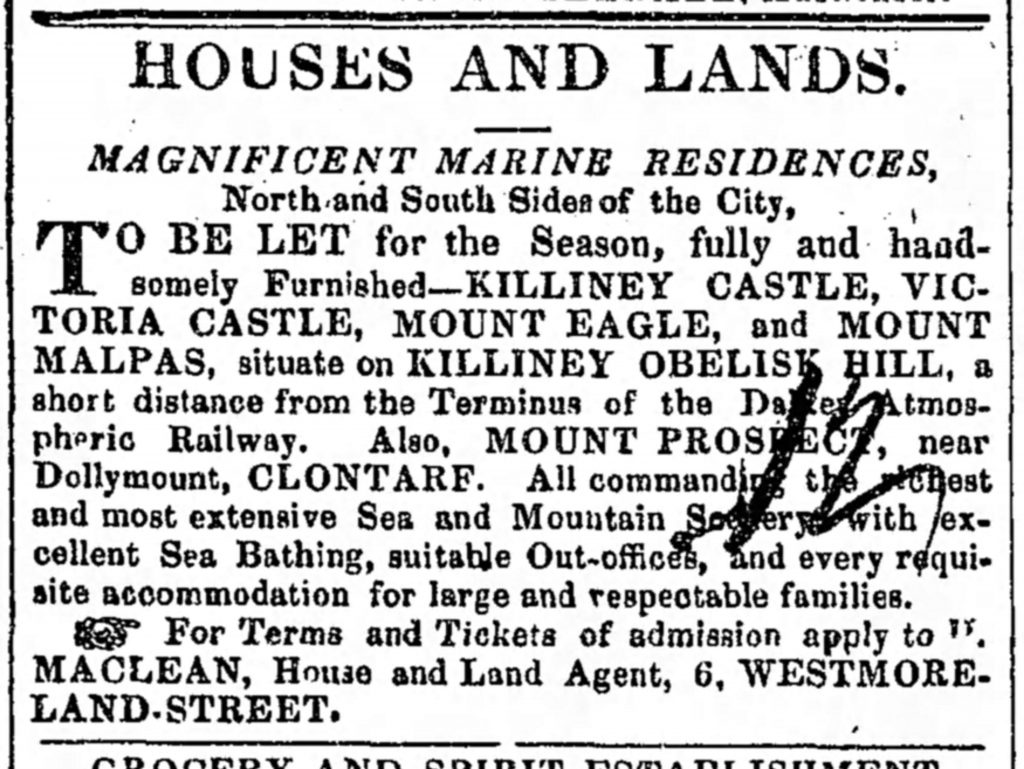
Over a more extended period of time, Warren built a number of houses from which he hoped to derive rent income. It looks as though more may have been spent on these houses than was strictly justified in terms of cost recovery. As the money ran out, Warren became unpleasant and quarrelsome. Neighbours faced threats of litigation. Tradesmen’s bills went unpaid. Vicious and unsuccessful attempts were made to coerce the Railway Company into buying additional land.

The crash came late in 1870. Warren had been involved in a consortium that bought up land in Foxrock and Galloping Green, with the intention of developing a network of roads and villas not dissimilar to that which was eventually built. The members of the consortium did not have access to the necessary seed-capital to begin building, and the whole venture went sour. Debts were called in, but after the sale of the sites at Foxrock and Galloping Green, Warren’s liabilities were still considerable. In 1871, the Landed Estates Court acted on the basis that the only way to clear these debts was to auction off the Killiney land.
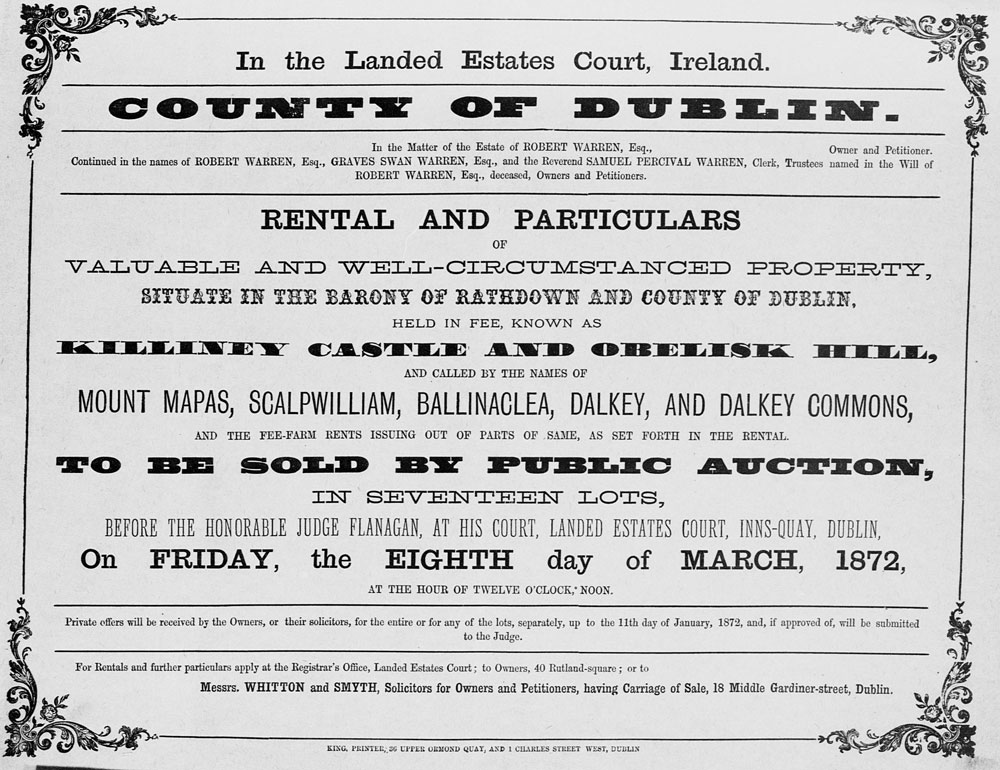
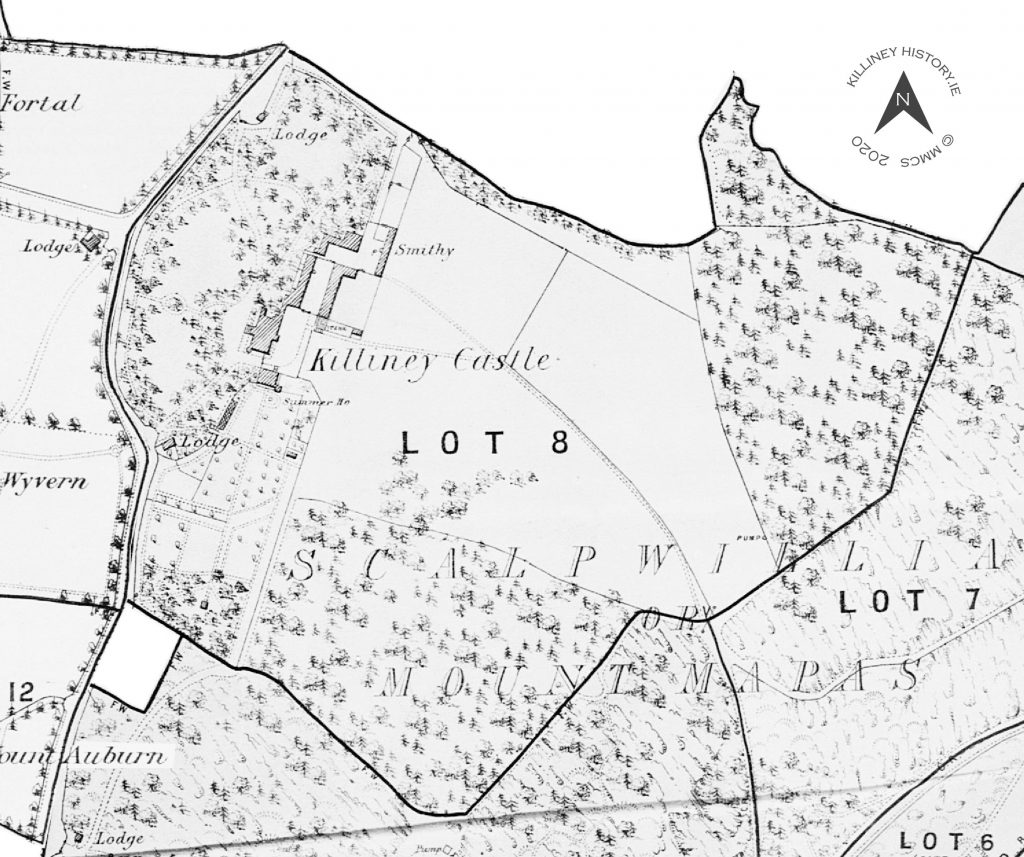

In the meantime, Warren approached other members of his family, and raised a certain amount of the outstanding sum, but the auction was still held. When Humphrey Lloyd, then Provost of Trinity College, bought Victoria Castle for £5,000-0-0, Warren had sufficient money to settle with his main creditors. The remaining properties were withdrawn from auction when he paid over £11,000-0-0 to the Court. He stayed on in Killiney Castle for another year, before selling by private treaty to Richard Martin, DL. He left Killiney in the following year, after the sale of Mount Mapas and Mount Eagle.
In fact at this stage it was Robert Warren junior, who took over after the death of his father in 1869, who managed to resolve the outstanding debt issues on the estate. He had been living directly across the road from Killiney Castle in a house called Wyvern since 1860, when it was built. It appears that by selling off parts of the estate he managed to retain ownership of Killiney Park, Vico Fields and Wyvern. In 1887 he finally sold the main estate for £5,000 to allow for the creation of the public amenity we now know as Killiney Hill Park. It was not until 1889 that agreement was finally reached with the owners, including Warren, which allowed for the opening of the Vico Road to the public. He remained in Wyvern until his death in 1894.
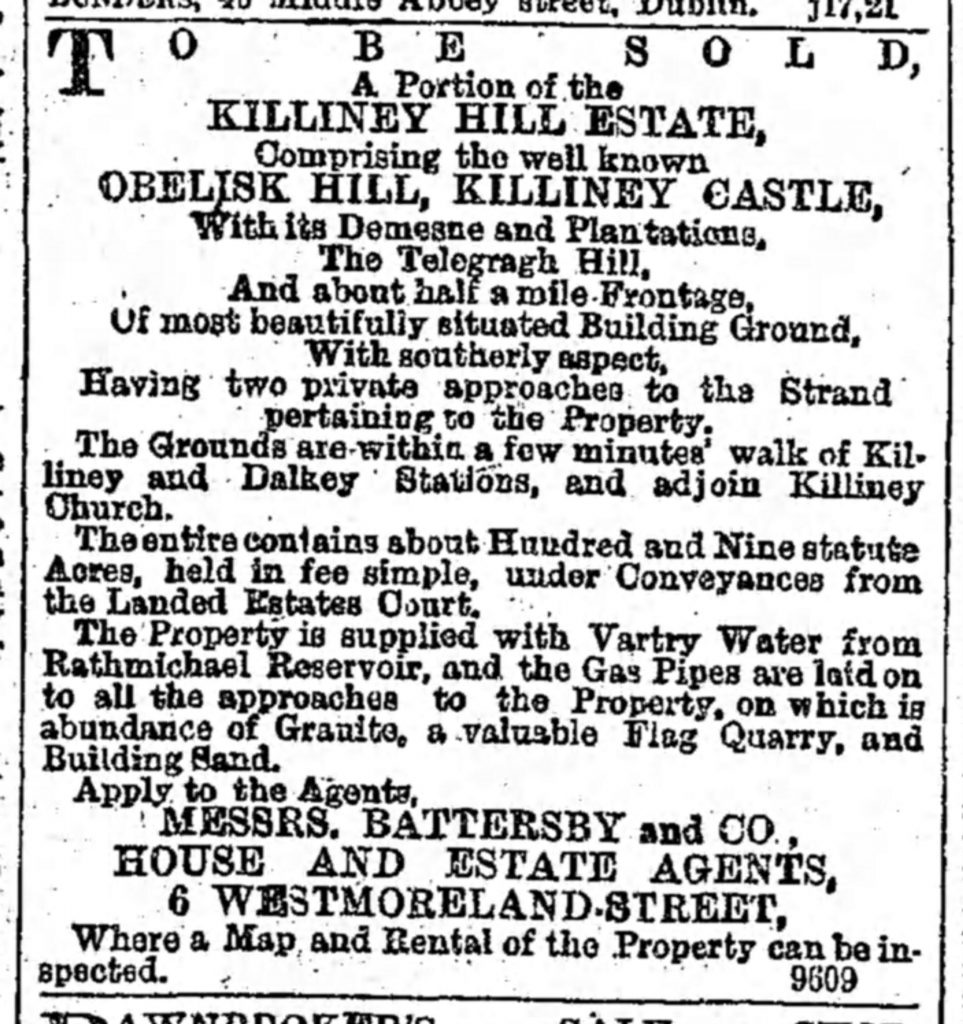
Mr. Warren’s gate lodges 1846
An unusual entry in the Tithe Applotment Book records dated 1846 includes a map showing Mr. Warren’s gate lodges and provides the names of the occupiers as Henry Hanlon, Michael Kenny (Front Lodge) and Ed Healy.
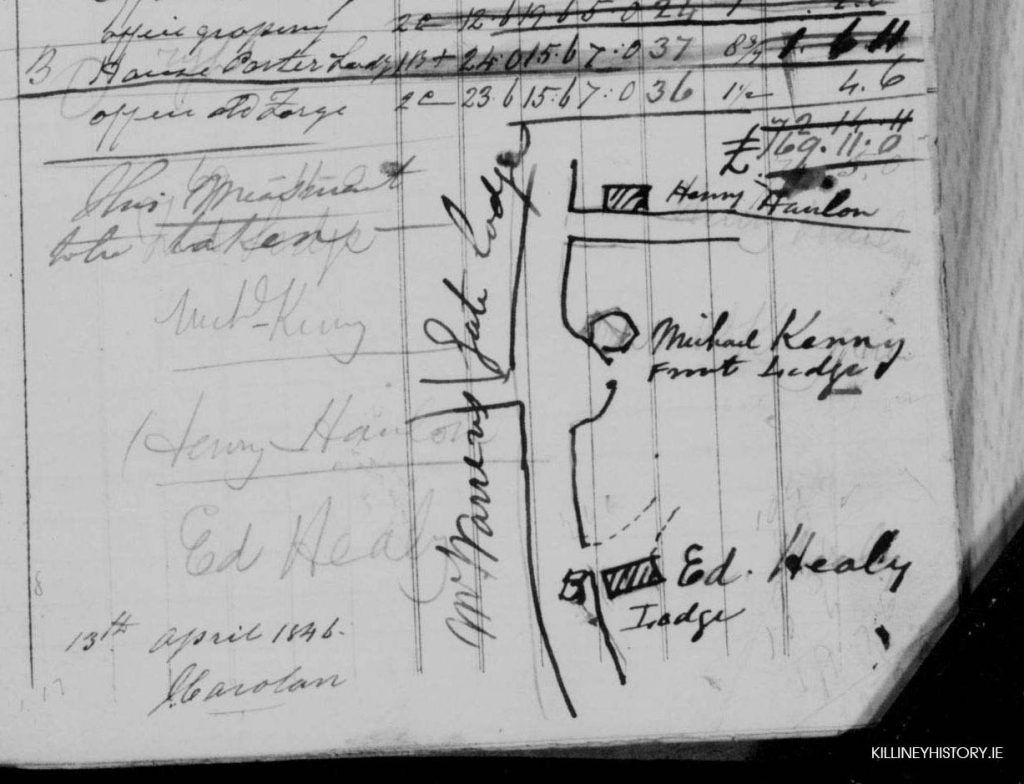
Robert Warren (Senior) 1787-1869
It appears that Robert Warren was a very determined individual. Whilst undertaking the development of Killiney Castle and Mount Mapas estate in 1834 he also bought a number of properties in Clontarf including Baymount Castle. The modifications which he made to Baymount bear a striking resemblance to the works carried out at Killiney Castle. There is no doubt the same hand was at work here, possibly overseen by his nephew and architect, Sandham Symes.
Below is an extract from ‘Baymount Castle, Clontarf’ by Bernadine Ruddy, 2006.

In 1838 Keily sold his interest to Robert Warren for £750. From a later deed dated 1842 between J.E.V. Vernon and Robert Warren we learn that the buildings were in a very dilapidated condition as Warren agreed to expend £2000 in reroofing and repairing the house, in building three coach houses, three stables, a steward’s office, two gate lodges and other improvements. Originally a Georgian house of three storeys over a basement, its appearance was altered by the addition of crenellations, which were also a feature of the stable yard. The castellated Gothic style was popular at the time and probably helps to explain the change of name from Baymount House to Baymount Castle. In return, J.E.V. Vernon added to the existing lease of 99 years a further term of 110 years to commence from 25 March 1833.
Robert Warren was an attorney who had offices in Cavendish Row, from which he later moved to 39 and 40 Rutland (now Parnell) Square West. His home address is given variously as either Seapark or Prospect House, Green Lanes, Clontarf, though in the Ordnance Survey Name Books for Co. Dublin he is described as the occupier of Prospect, while Seapark is referred to as his property. The latter is apartment complex, while Prospect House is a convent. Robert Warren was wealthy and ambitious and during the 1830s leased various plots of land in Dollymount from J.E.V. Vernon. In 1835 there is a record of two deeds, a number that increased to twelve the following year as he sought to build up his holding of land in the area round Green Lanes, the present day Mount Prospect Avenue. In 1843 he moved to Baymount Castle and this became his home until he moved to Killiney three years later. He set about improving and upgrading Baymount Castle, landscaping the grounds, laying our lawns and gardens: “large sums of money [were] expended in making gardens lawns and pleasure grounds and other additions erections and lasting and valuable improvements.”
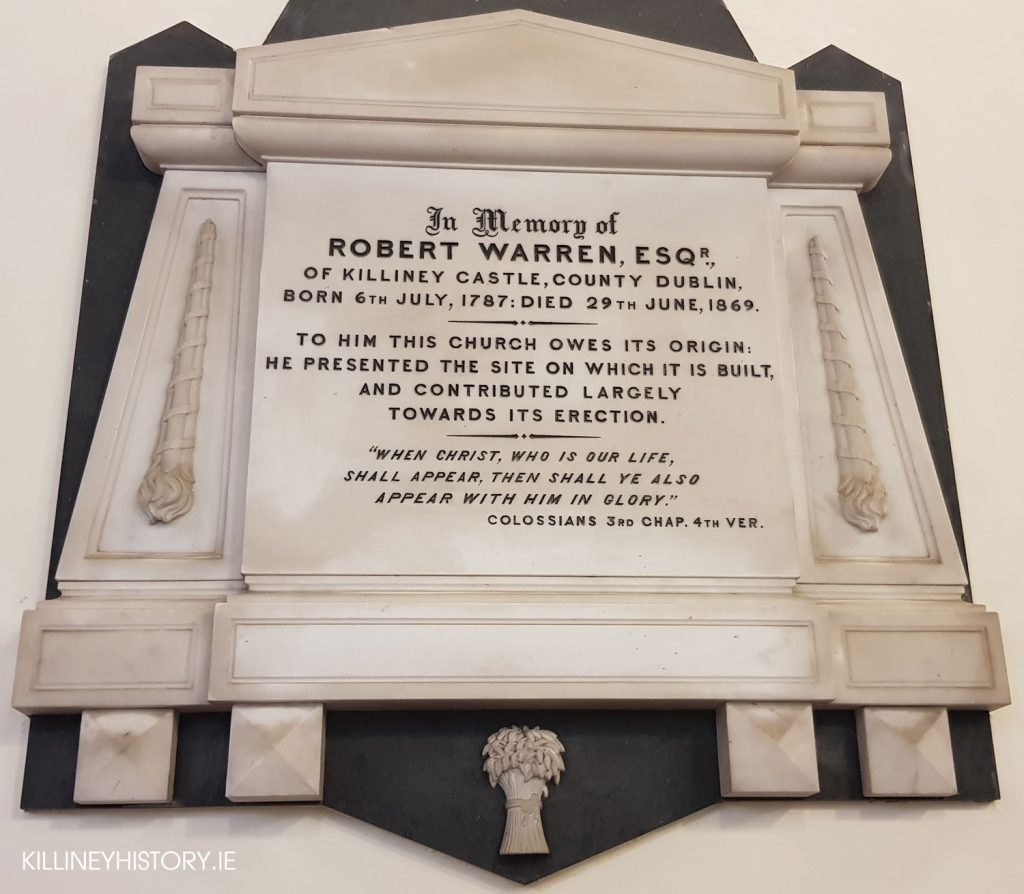
He was interested and active in public life. With John H. Nicholson he represented the District of Clontarf on the North Dublin Union Workhouse and in his professional life he was a committee member of the Society of Attorneys and Solicitors of Ireland. He was also a director of the Dublin, Wicklow and Wexford Railway, a magistrate and deputy lieutenant of County Dublin. After leaving Baymount, he lived in Killiney Castle and later in life became one of the principal proponents of Killiney township when it was set up in 1866. He became its first chairman, a position he held for almost 25 years.
Actually it was his son, Robert Warren Junior, who retained the position of chairman up until c.1888 and he appears to have been the first chairman of Killiney & Ballybrack Township since its inception in 1866. Robert Warren senior died in 1869.
Warren and the railway
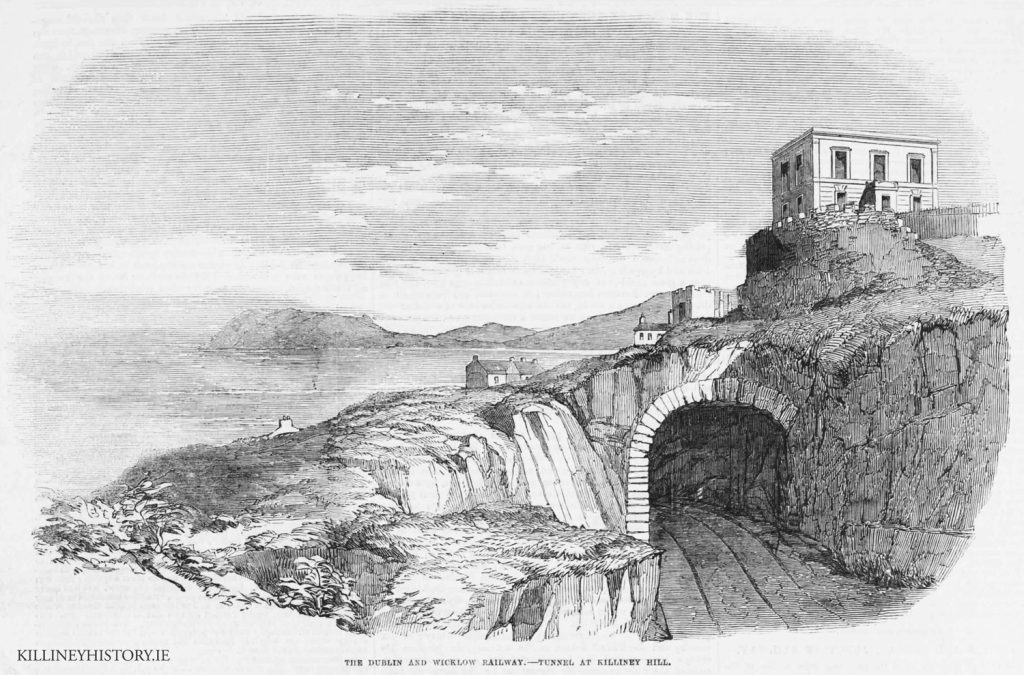
Owning the strategic coastal lands which would allow the connection of the existing train service to Dalkey further down the coast to Bray and beyond gave Warren great leverage with the Railway Company. His successful negotiations resulted in the opening of the line from Dalkey upon the construction of a tunnel through the granite foreshore at Sorrento point linking to the Vico fields. Part of the deal was the construction of Obelisk Hill Station right in the middle of Warren’s property which added great value to his lands and increased the pace of development in the area. Read further about his dealing with the Waterford, Wexford and Wicklow Railway Company here.
Thomas Chippendall Higgin
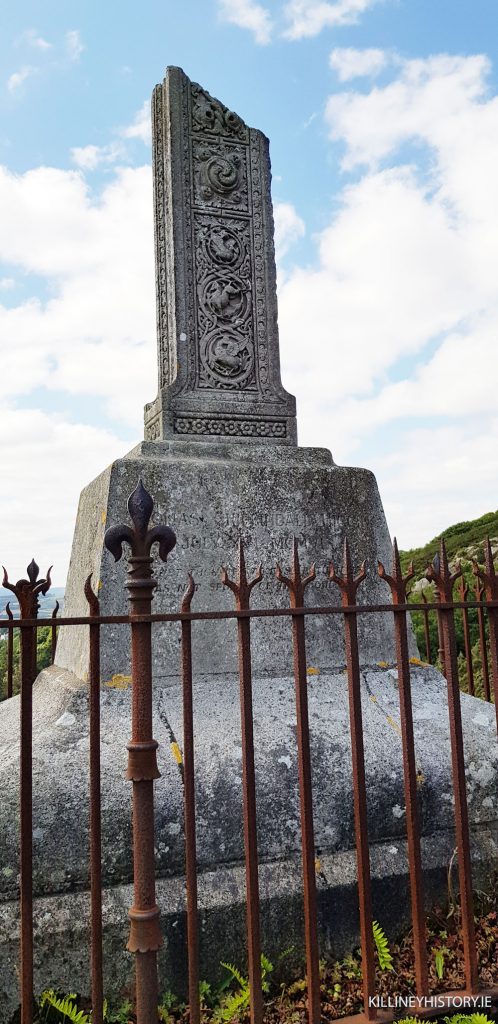
A later inhabitant named Thomas Chippendall Higgin, who bought the castle c.1880, added a half-octagonal castellated tower, cut-stone doorway and entrance porch to the front. The door-case with its carved plaque and swan-neck pediment is in the seventeenth-century style. Higgin had the unusual distinction of being buried on Dalkey Hill in 1906, where a broken cross bears the inscription: ‘Dust thou art, to dust returneth, Was not spoken of the soul’.
Killiney Hill by F.E. Ball (1902)
Francis Elrington Ball. History of the County of Dublin (1902) pp 56-59
Killiney Hill stands in the townland of Mount Mapas, or Scalpwilliam. The lands of Scalpwilliam are first mentioned under that name in the beginning of the seventeenth century, and from that time followed the same devolutions of ownership as the Rochestown property. The obelisk, which stands on the summit of the hill, and which is a very prominent object, was erected by Mr. John Mapas, in 1741, a year of scarcity and hardship, when fever and famine devastated Ireland. It bears the quaint inscription: “Last year being hard with the poor, the wall around these hills and this were erected by John Mapas, Esq. June, 1742.”
About the same time a house had been built on or near the site of Killiney Castle. It contained considerable accommodation, and its sea and land prospect was accounted the finest in Ireland. Except towards the sea, “where nature had sufficiently enclosed them,” the lands were surrounded by a stone wall, and were estimated to contain some 150 acres. The house had been originally called Mount Mapas, but, in 1755, was known as Roxborough. It was then in occupation of Captain Edward Maunsell, who served as High Sheriff of the County Dublin in that year. He had married a daughter of Philip Ridgate, LL.D., the widow of Mr. William Roberts, and on his death, which took place in 1765, in York-street, Dublin, left by her an only son. This son, Thomas Ridgate Maunsell, afterwards resided with his mother in Rochestown-avenue, and devoted much time to genealogical research, with the object of compiling a history of his family. Lead had been discovered on the lands of Roxborough, and mines had been, in 1751, opened, which, two years later, when a vein of great thickness was discovered, were reported to be in a most flourishing condition. They were closed a few years later, and a second attempt to work them in 1784 proved equally unsuccessful.

Before his death Captain Maunsell assigned his interest in Roxborough to Colonel the Hon. Henry Loftus, M.P. for Bannow, in the County Wexford, the central figure in one of the most protracted and keenly-contested legal struggles of the eighteenth century. He was a descendant of the great Archbishop Loftus, of Elizabeth’s reign, and was younger son of Nicholas Loftus, of the County Wexford, who was created a peer as Baron Loftus and Viscount Loftus of Ely. His brother, who had succeeded to those titles on the death of their father, and who had in addition been created an earl, died in 1766, leaving an only son. This son, now the second earl, who was of extreme delicacy of constitution, and had been persistently neglected and ill-treated by his father, was taken by his uncle, Colonel Loftus, under his protection. Through his mother, a daughter of Sir Gustavus Hume, of the County Fermanagh, who had long pre-deceased her husband, the young earl was entitled to large property, and his mother’s family had, before his father’s death, instituted proceedings to prove that he was incapable of managing his affairs. His case was ably conducted by his uncle (it did not come on for trial until after his father’s death), and the decision was in favour of the young earl’s sanity. Three years later, in spite of every care on his uncle’s part, the young man died, making a will, by which he bequeathed all his property to his uncle. His mother’s relatives sought to have this will set aside, as obtained by undue influence, but were again unsuccessful, and Colonel Loftus succeeded to his nephew’s estates, as well as to the barony and viscountcy. The pages of ” Baratariana,” where the colonel figures prominently as Count Henrico Loftonzo, allege that he deserted his old political friends to obtain a favourable decision from “the innocent Phil Tisdal,” who was Judge of the Prerogative Court, as well as Attorney-General, and also tell of the efforts of his wife to secure Lord Townshend, then Lord Lieutenant, as husband for her niece, the lovely Dolly Monro, and Loftonzo’s own intrigues to obtain an earldom., which was afterwards conferred on him.
Possessed with an unbounded passion for improvement, and a skill equal to that passion, as a contemporary writer says, Loftus converted the barren hills and rocks round Roxborough, called by him Loftus Hill, into good meadow and pasture lands, frequently being obliged to blast the rock, and to draw earth to cover it, in order to obtain his object. Round the hill he cut the present road, and planted the west side with trees and shrubs. The house was a large one, but the offices were small. It was his intention to rebuild them, but this he did not accomplish, as in Rathfarnham Castle, the ancient seat of the family, which he repurchased for his nephew, and succeeded to himself, he found greater scope for the extravagant magnificence which is displayed in the classic gateway on the Dodder, constructed by him. After his succession to the titles Lord Loftus disposed of Loftus Hill; in 1778 it was occupied by Mr. Medlicott, and subsequently by Mr. Minchin.
The hill was, in 1790, taken by Lord Clonmell, with the intention of erecting a mansion there in place of his seat at Temple Hill, but his improvements ended in the construction of a park, at a cost of some £3,000 which, on its completion, he stocked with deer. Nearly 200 men were employed by him at one time in that work, and in making roads and planting. A tourist in 1796 describes a handsome banqueting hall, which was built by Colonel Loftus, and mentions that, in addition to the obelisk, which Lord Clonmell had restored, a memorial was about to be placed on the hill, in pursuance of the will of the last Mr. Mapas, who left a large sum for the erection of a monument to his family. During the last century the neighbourhood was much developed by Mr. Robert Warren, of Killiney Castle, whose name, as its restorer in 1840, the obelisk bears, and the hill having been purchased for a park, was, in 1887, opened and dedicated to the public use by the late Prince Albert Victor of Wales, in memory of Queen Victoria’s Jubilee.
Extract from ‘Some Residents of Monkstown’ which mentions Loftus Hill and the Malpas connection
By Francis Elrington Ball from: The Journal of the Royal Society of Antiquaries of Ireland , Sep. 30, 1899, Fifth Series, Vol. 9, No. 3 (Sep. 30, 1899), p. 240
We pass then through Dalkey, a decayed and deserted town, and come to Loftus Hill, the residence of Colonel the Hon. Henry Loftus, M.P., for Bannow, in the County Wexford. The name of this house has been several times changed ; built by the Malpas family, who own the soil, it was originally called Mount Malpas; then Captain Edward Maunsell, who occupied it for some years, called it Rocksborough; and now Mr. Loftus has changed its name to Loftus Hill. He has rebuilt the house, and, possessed of an unbounded passion and skill for improvement, has reclaimed the land, and planted the gardens with every kind of fruit tree, and with a most superb collection of flowers.
See Faulkner’s Dublin Journal, Sept. 23-26, 1752, for advertisement of Roxborough, formerly called Mount Malpas, containing about 150 acres of land, enclosed by a stone wall, and a new, well-finished house of six rooms and two large closets on a floor, with offices. Also see ” Topographical Description of Dalkey and the Environs “by Peter Wilson in Exshaw’s Magazine for 1770, p. 489, and lease from Malpas to Maunsell of July 12, 1763, and from Maunsell to Loftus of Feb. 28,1764, in Registry of Deeds Office. Loftus Hill appears to have been on the site of the present Killiney Castle. In 1790 Killiney Hill was in the possession of Lord Clonmell, the Chief Justice of the King’s Bench. It was said he was about to build a house there, and he had about 190 labourers employed in making roads. See Stealer’s Dublin Chronicle, Nov 11, 1790.
Unpleasant neighbours
By Francis Elrington Ball from: The Journal of the Royal Society of Antiquaries of Ireland , Sep. 30, 1899, Fifth Series, Vol. 9, No. 3 (Sep. 30, 1899), p. 241
Adjoining Loftus Hill, in a small house called Ballinclay, lives Sir Oliver Crofton, a baronet of not the most immaculate character. Loftus has found him anything but a pleasant neighbour. Last year he threw down their boundary wall, and Loftus had to seek the protection of the House of Commons on account of his conduct, and that of his servants, two of whom were taken into custody by the serjeant-at-arms. Some twenty-five years ago he stood his trial for killing Mr. John Massy, of Duntrileague, in a duel; and his proceedings after the death of his predecessor in the title did not raise his reputation.
‘Nonsense set upon a hill’

A less complimentary writer in the Dublin Penny Journal of August 1834 describes the house thus:
the residence of some foolish city Goth who has contrived to make a burlesque upon castellation by affixing certain indentures to the top of his house like the toothed deed by which he himself was bound over to an attorney or dealer; and with the accompaniments of slashes in the walls and things like mustard pots and pepper castors at the corners, has turned a good old plain country mansion into a Babel building, where all art is confounded, taste abused and there it stands like a fool upon a cock-horse; nonsense set upon a hill.
Brendan Behan and the IRA, 1939
In Brendan Behan: A Life by Michael O’Sullivan 1997 a mention is made of Brendan Behan and his links to Killiney Castle:
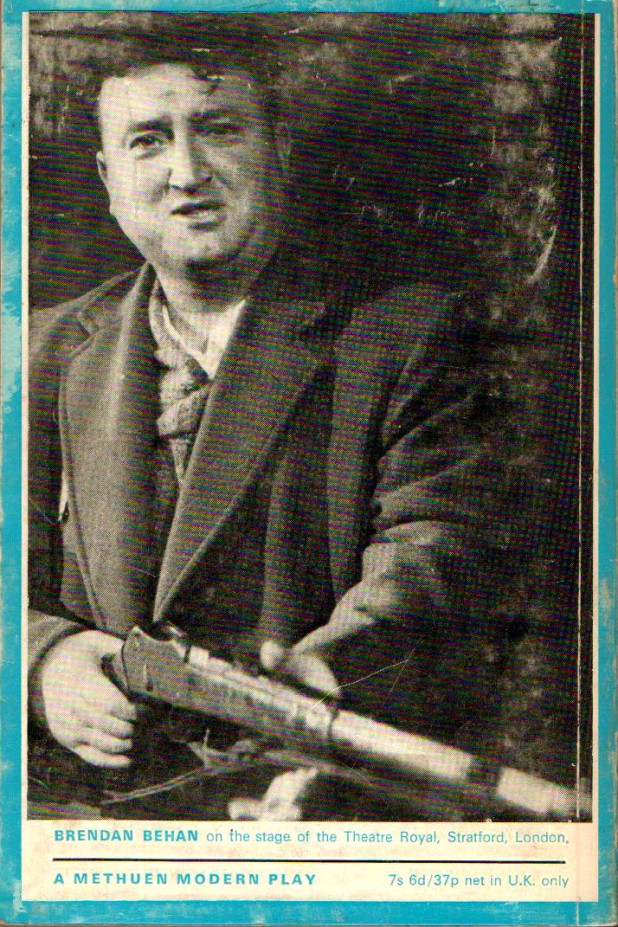
In 1939 (aged 16), having served his apprenticeship as a painter and decorator, he was accepted into the adult ranks of the IRA and began his training in the tactics of guerrilla warfare and bomb-making at a secret camp in Killiney Castle. Throughout 1939 the IRA had waged a relentless bombing campaign in England and Behan wanted to be part of it. It is not clear whether his decision to go to Liverpool with his own bomb-making kit and a false travel permit was sanctioned by his superiors, but within ten hours of landing on English soil he was arrested and later sentenced to three years in borstal.
In 1943 the property was described as Military quarters in Thom’s directory so the military link is certainly correct although the owner in 1939 is listed as Michael J. Heeney.
Records from Thom’s Directory and other sources
RESIDENTS OF KILLINEY CASTLE
c.1843-1869 Robert Warren senior
1858 Robert Warren, solicitor. Greaves S. Warren, solicitor. Robert Warren junior, barrister J.P. Rev. Samuel P. Warren. (source: Post Office Dublin Directory 1858)
1869 Robert Warren senior dies on 29th June 1869
1871 Mrs. Warren
1872 Robert Close, Esq
1873 Robert Warren (junior), Esq., Solicitor
1874 Richard Martin, Esq., DL
1875-1876 Vacant (Owned by Martin)
1877-1880 Jesuit House
1880-1906 T. Chippendall Higgin (In 1906 Chippendall Higgin moved to Telegraph Hill)
1907-1936 Alfred.H. Ormsby-Hamilton, MA, DL, Barrister-at Law
1937 Vacant (Ormsby-Hamilton was listed in the rating field-book as the owner in fee)
1938-1948 Michael J. Heeney (Heeney’s ground landlord was the Dun Laoghaire Borough Council)
1940 Vacant
1943 Military quarters
1947 Gordon Gisborne, Killiney Castle Hotel Poultry Products
1948-1955 Patrick Keenan (Killiney Castle became the Killiney Castle Hotel in c.1947)
1960 Ambrose Murphy
